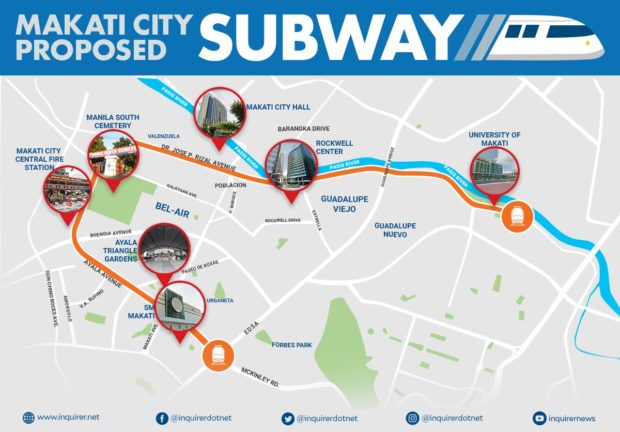
The construction of the $3.7-billion intra-city subway project in Makati City will begin in December 2018. INQUIRER.net file photo /ED LUSTAN
MANILA, Philippines–Publicly listed Philippine Infradev Holdings Inc. — formerly known as IRC Properties Inc. — has begun the first physical phase of its proposed Makati City subway by undertaking soil testing ahead of the $3.7-billion project’s actual construction.
The six-month geo-testing involves boring small holes and getting soil and rock samples for analysis from at least 200 points along the proposed subway alignment. The process will last for six months and is part of preliminary works prior to official groundbreaking.
The ceremonial drilling in front of the old Makati City Hall was witnessed by top IRC executives along with Makati Mayor Abby Binay, Vice Mayor Monique Lagdameo, former Vice President Jejomar Binay and other city officials.
Earlier, Mayor Binay and IRC chair Ren Jinghua also led the unveiling of a scale model of Makati City highlighting the proposed subway route. The detailed scale model is open for public viewing at the city hall lobby.
READ: Work on Makati subway to start in December –Binay
She said the proposed subway would be a valuable legacy to the country’s premier financial district.
“I’m fully committed to its timely completion and operation. It will make a lasting positive impact on the lives of our residents and workers, and contribute significantly to the city’s sustainable development and economic growth,” Mayor Binay said.
Last October, Makati’s public-private partnership selection committee gave IRC the green light to proceed with the subway project after the firm hurdled a 30-day competitive Swiss challenge process.
The project will involve no cash outlay from the Makati City government which will, instead, allow the land it currently owns to be used for the subway system as part of the joint venture deal.
IRC’s plan calls for the subway to connect key points in Makati such as the current Central Business District along Ayala Avenue, the Makati City Hall, the Poblacion Heritage Site, the University of Makati, Ospital ng Makati and the other new business districts within the city.
The proposed dual track subway system will have up to 10 air-conditioned, underground stations that can accommodate up to six car trains, with a room for over 200 passengers per car. Over 700,000 passengers per day will be accommodated and served by the proposed mass transport system.
During the construction phase, the project is expected to generate more than 6,000 jobs, according to IRC.
The planned intracity subway is expected to complement the mass transport projects of the national government, since it would be connected to the MRT stations, the proposed Metro Manila Mega Subway and the Pasig River ferry. /jpv